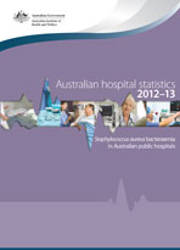Summary
This report presents national information on cases of Staphylococcus aureus bacteraemia (SAB) associated with care provided by public hospitals for the period 1 July 2012 to 30 June 2013. This report builds on robust national and jurisdictional arrangements to monitor and reduce SAB.
What is SAB?
- SAB is a serious bloodstream infection that may be associated with hospital care. As such, it is known as a type of healthcare-associated infection.
- Patients who develop bloodstream infections such as SAB are more likely to suffer complications that result in a longer stay in hospital and an increased cost of hospitalisation. Serious infections can also result in death.
- In December 2008, Australian health ministers endorsed the reporting of SAB by all hospitals to form a national data collection.
- In addition, in 2008, rates of SAB, including cases caused by methicillin-resistant Staphylococcus aureus, were announced as one of the performance indicators to be reported by jurisdictions under the National Healthcare Agreement.
SAB rates in 2012-13
- In 2012-13, all states and territories had rates of SAB below the national benchmark of 2.0 cases per 10,000 patient days. The national rate was 0.9 cases per 10,000 patient days.
- The rates ranged from 0.7 per 10,000 patient days in the Northern Territory to 1.3 per 10,000 in the Australian Capital Territory.
- There were 1,724 cases of SAB reported in Australian public hospitals, of which 77% were methicillin sensitive, and therefore treatable with commonly used antibiotics.
- The reported SAB cases occurred during 18.8 million days of patient care under SAB surveillance during 2012-13.
- Between 2010-11 and 2012-13, the national rates of SAB decreased from 1.1 cases per 10,000 patient days under surveillance to 0.9 cases per 10,000. Rates decreased in New South Wales and the Northern Territory, rose in the Australian Capital Territory, and fluctuated or remained about the same in the other states.



